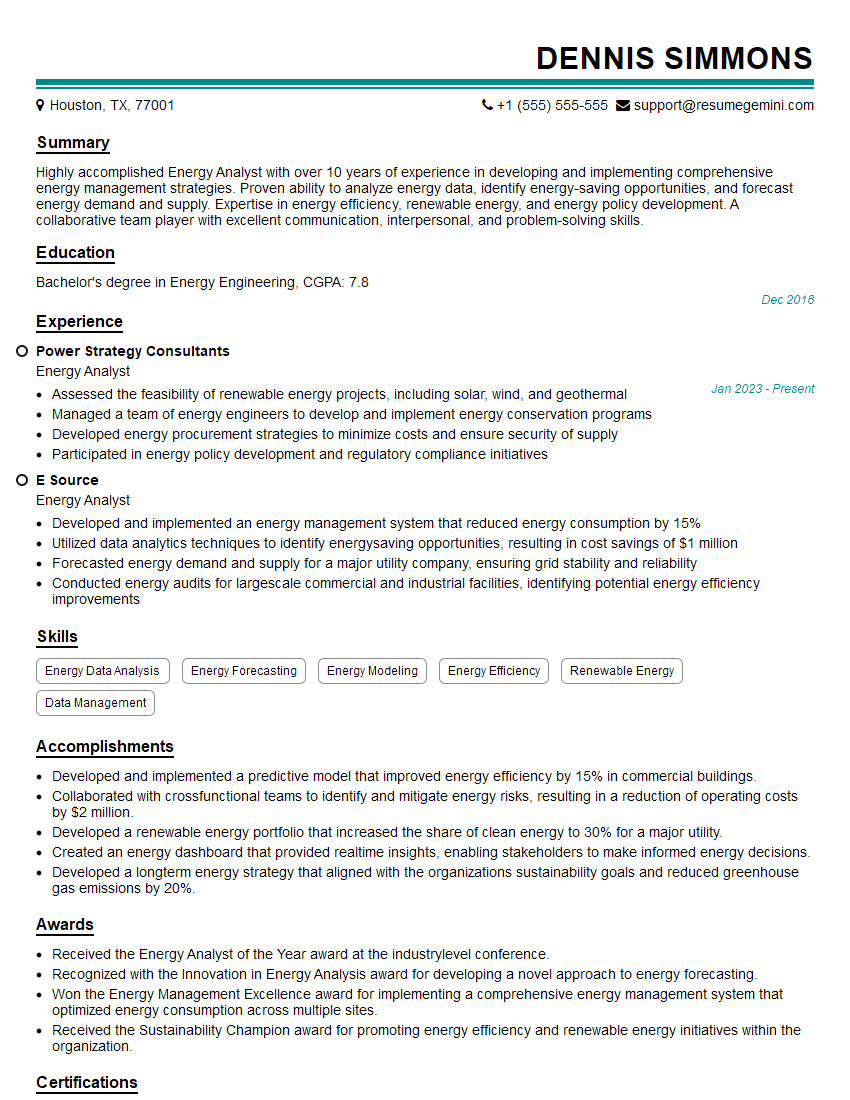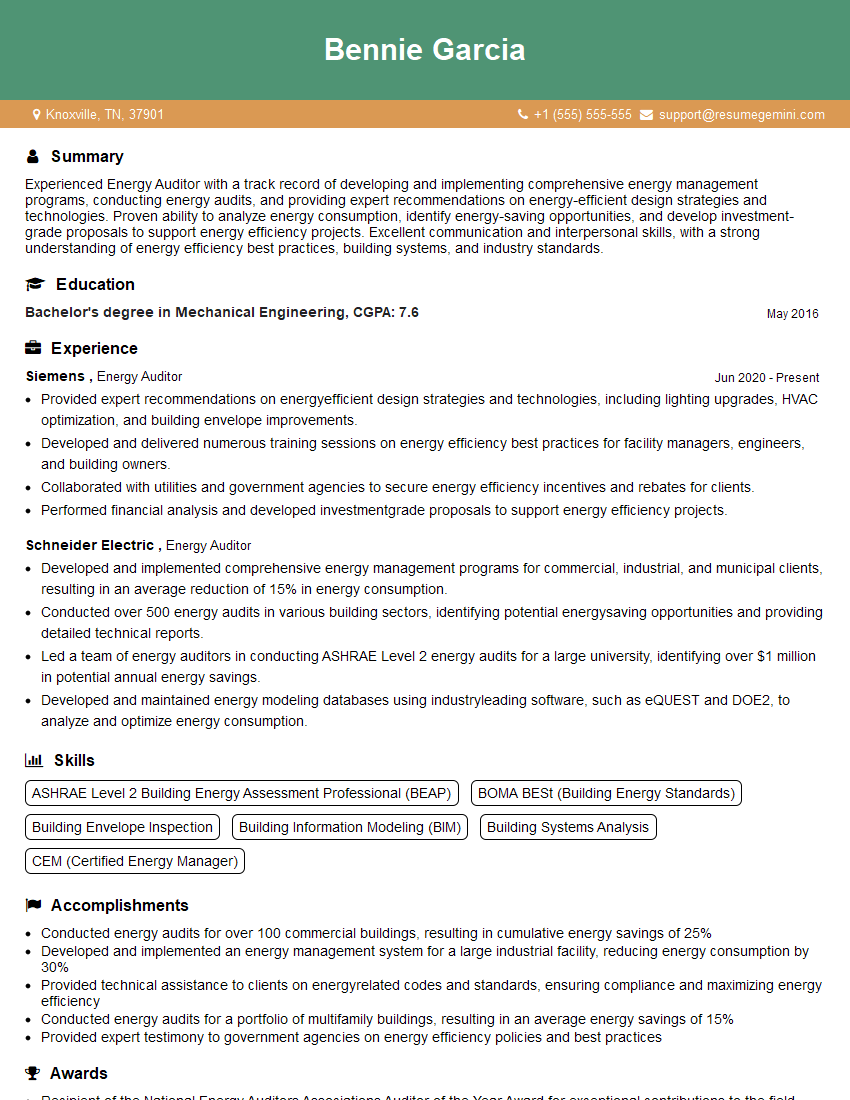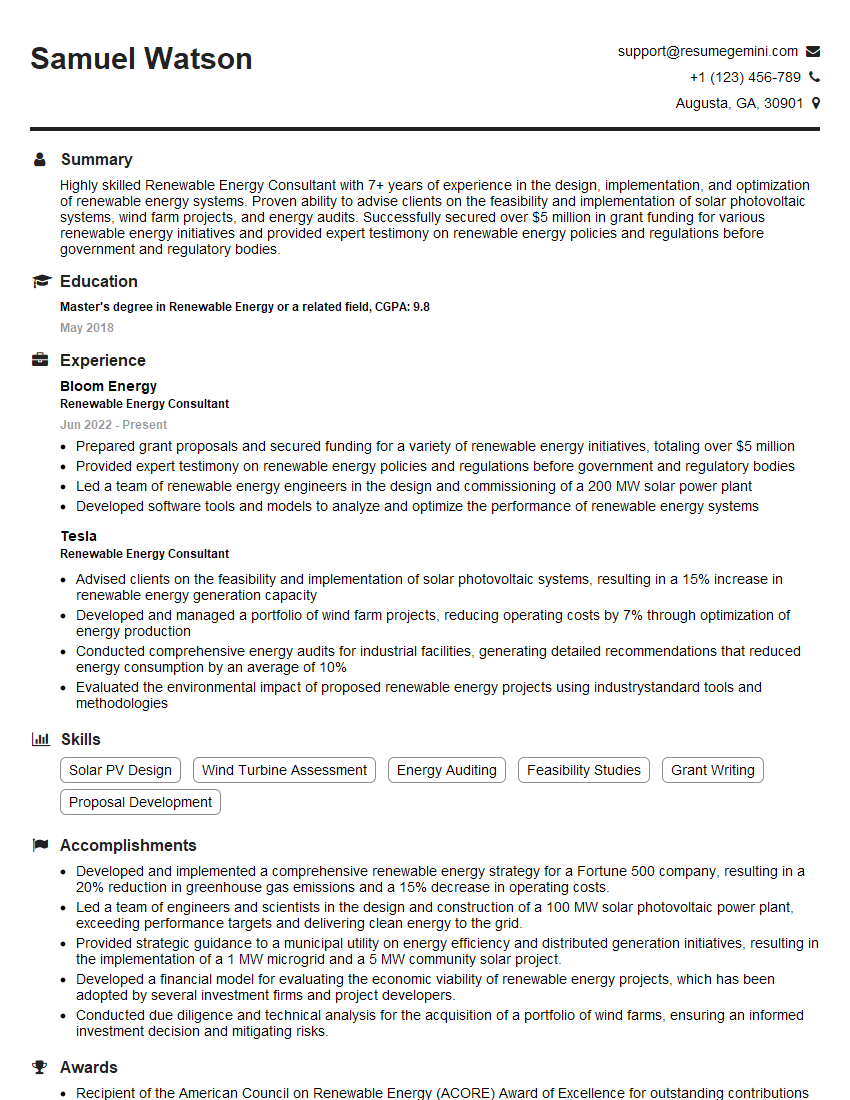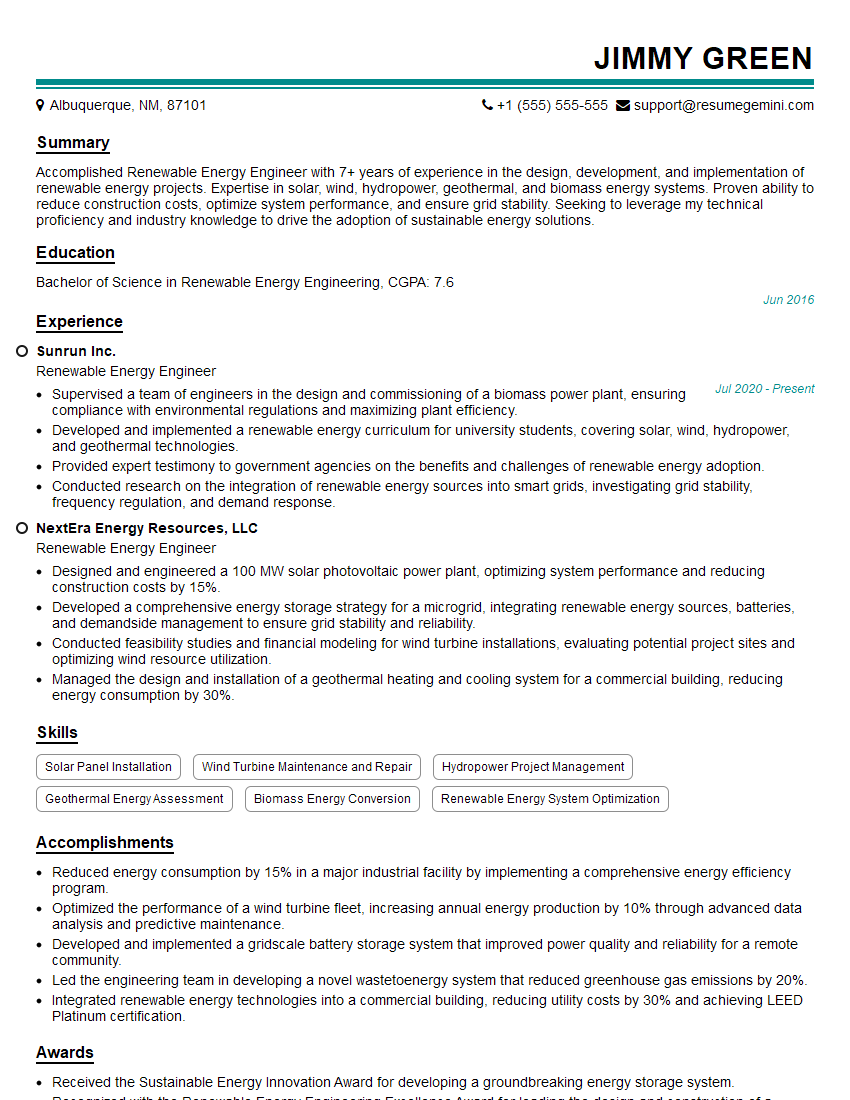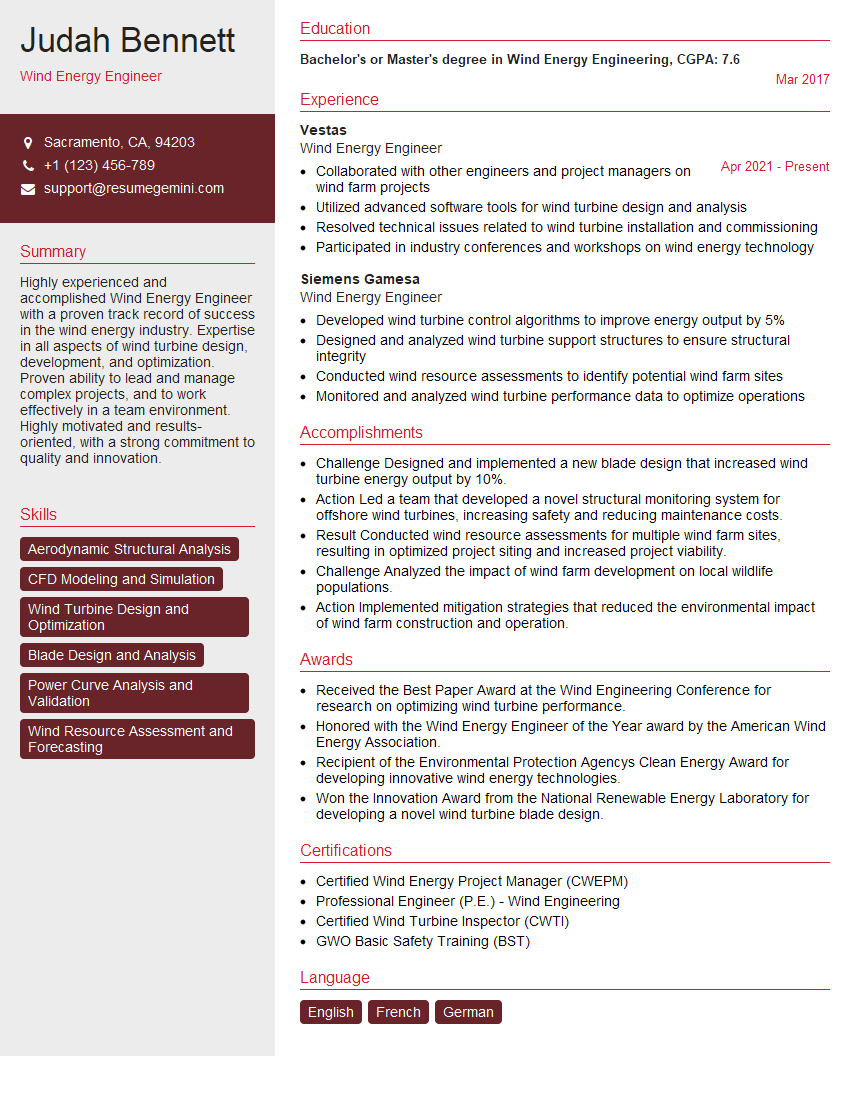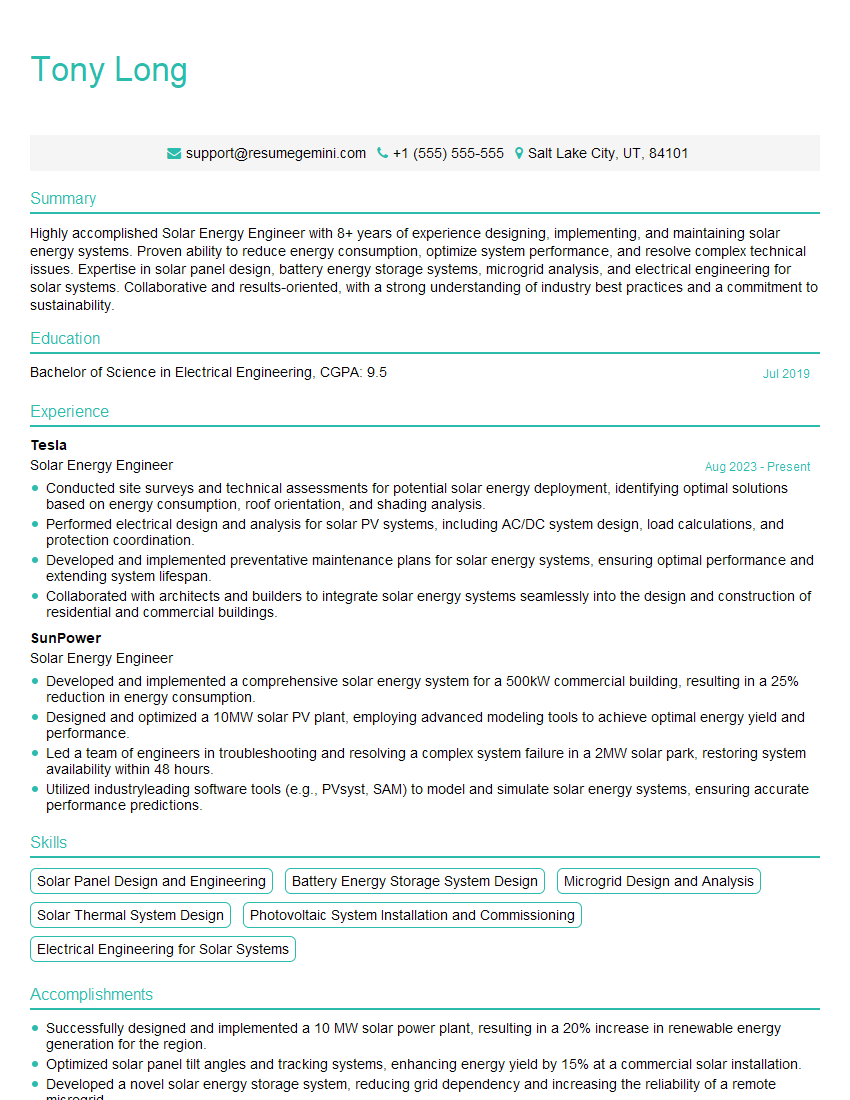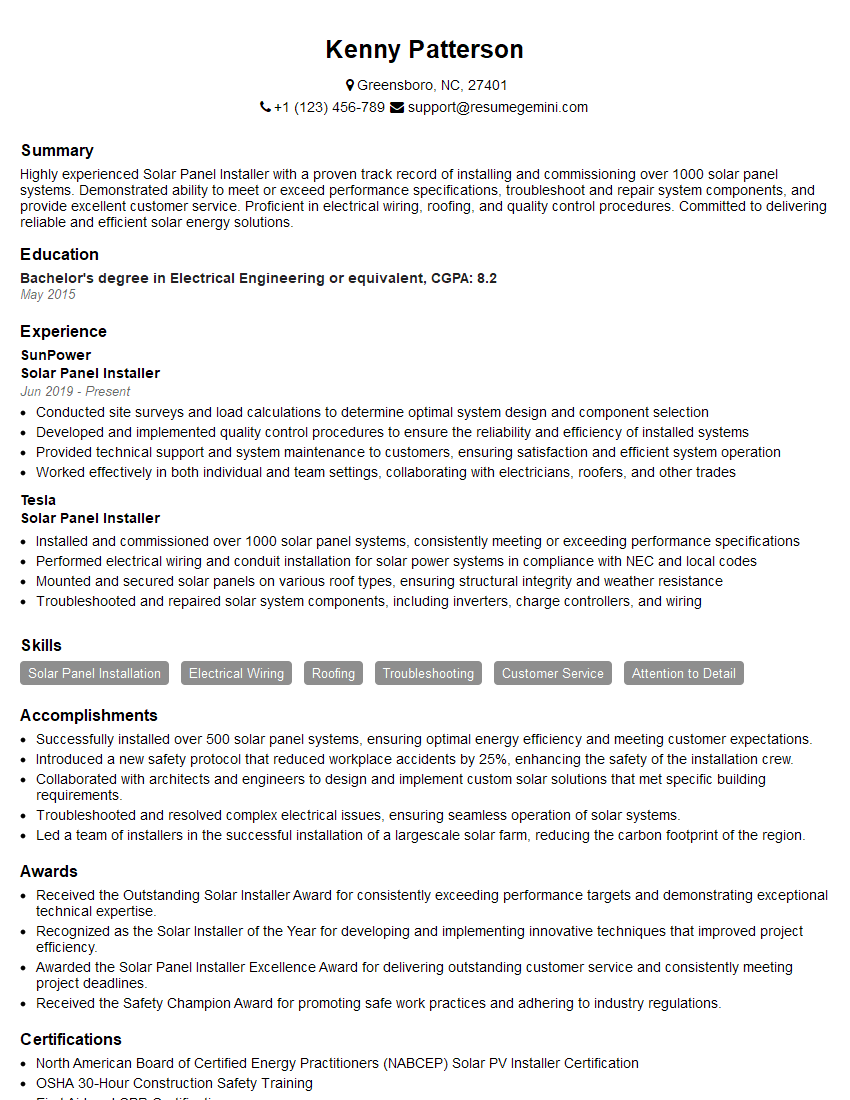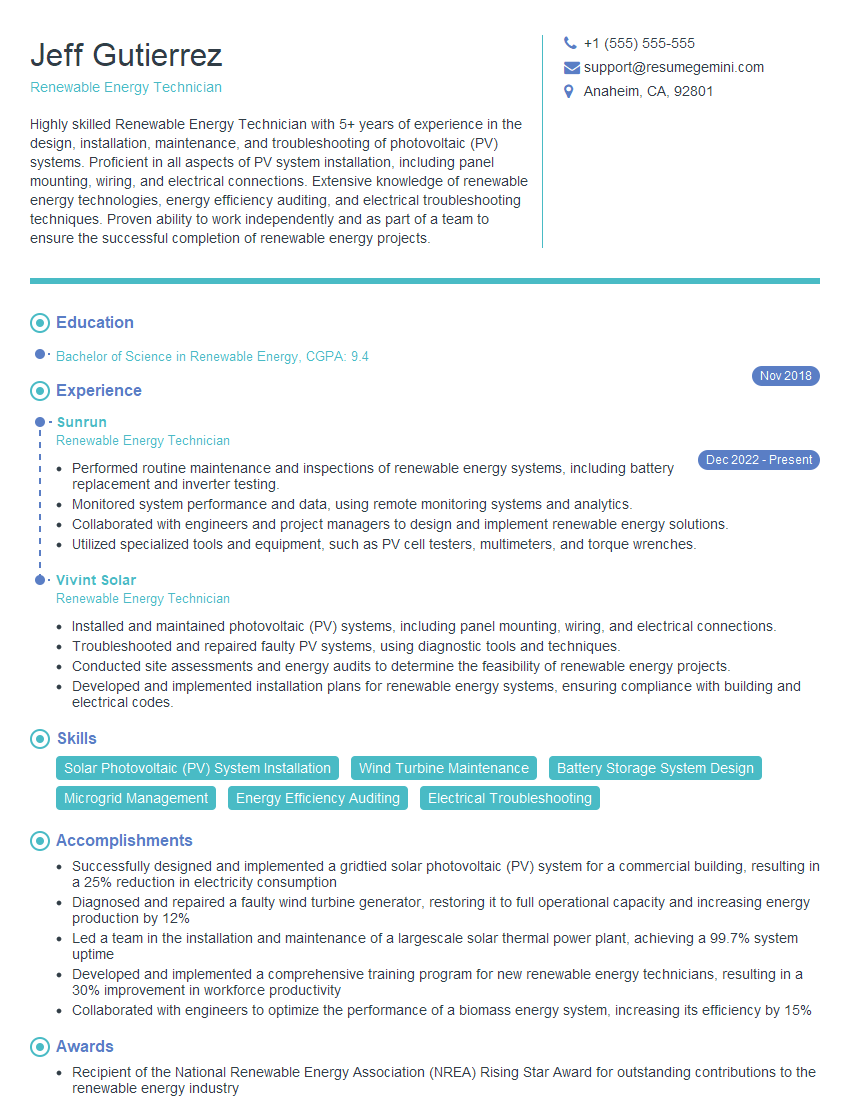Feeling uncertain about what to expect in your upcoming interview? We’ve got you covered! This blog highlights the most important Renewable Energy Fundamentals interview questions and provides actionable advice to help you stand out as the ideal candidate. Let’s pave the way for your success.
Questions Asked in Renewable Energy Fundamentals Interview
Q 1. Explain the difference between photovoltaic and concentrated solar power.
Both photovoltaic (PV) and concentrated solar power (CSP) harness the sun’s energy, but they do so in fundamentally different ways. PV systems use photovoltaic cells—semiconductor devices that directly convert sunlight into electricity. Think of it like a leaf using photosynthesis but generating electricity instead of sugar. CSP systems, on the other hand, use mirrors or lenses to concentrate sunlight onto a receiver, heating a fluid (often water or molten salt) that then drives a conventional power generation system, typically a steam turbine. It’s like using a magnifying glass to focus the sun’s rays onto a single point, creating enough heat to boil water.
The key difference lies in their energy conversion mechanism. PV is a direct conversion, while CSP is an indirect conversion that requires a heat transfer medium. CSP systems are generally better suited for large-scale electricity generation in areas with high solar irradiance and consistent sunshine, while PV is more versatile and can be implemented in various sizes and locations.
Q 2. Describe the various types of wind turbines and their advantages/disadvantages.
Wind turbines are broadly classified into two main types: horizontal-axis wind turbines (HAWTs) and vertical-axis wind turbines (VAWTs).
- Horizontal-Axis Wind Turbines (HAWTs): These are the most common type, with the rotor shaft oriented horizontally and parallel to the ground. They typically have three blades and capture energy from the wind blowing perpendicular to the rotor plane.
- Advantages: High efficiency, established technology, mature supply chain, cost-effective for larger scales.
- Disadvantages: Requires a yaw mechanism to orient the turbine towards the wind, prone to damage from extreme weather, potentially noisy.
- Vertical-Axis Wind Turbines (VAWTs): In VAWTs, the rotor shaft is oriented vertically. These turbines can capture wind from any direction without needing a yaw system.
- Advantages: Can operate in turbulent winds, simpler design, potentially lower construction costs.
- Disadvantages: Lower energy capture efficiency compared to HAWTs, complex aerodynamics, typically more suitable for smaller installations.
Other less common types include Darrieus turbines (a type of VAWT) and Savonius rotors (another type of VAWT), each with their own specific advantages and limitations. The choice of turbine depends greatly on factors such as wind resource characteristics, site conditions, and economic considerations.
Q 3. What are the main components of a solar photovoltaic (PV) system?
A typical solar photovoltaic (PV) system comprises several key components working together to generate and distribute electricity:
- Solar Panels (PV Modules): These are the heart of the system, containing numerous photovoltaic cells connected in series and parallel to produce a usable DC voltage. The cells are made of silicon and convert sunlight into direct current (DC) electricity.
- Inverters: These devices convert the DC electricity produced by the panels into alternating current (AC) electricity, which is compatible with the household electrical grid and most appliances.
- Mounting System: This structure supports the solar panels, ensuring optimal angle to the sun and protection from weather elements.
- Wiring and Connectors: These connect the various components and enable the flow of electricity throughout the system.
- Charge Controller (for battery systems): In systems with battery storage, a charge controller regulates the flow of electricity to and from the batteries, preventing overcharging or discharging.
- Batteries (optional): Batteries store excess electricity generated during peak sunlight hours for use later in the day or during periods of low sunlight.
- Meters and Monitoring Systems (optional): These track the system’s performance and energy production.
A well-designed PV system optimizes all these components for maximum efficiency and reliability.
Q 4. Explain the concept of the energy payback time for renewable energy technologies.
Energy payback time (EPBT) represents the time it takes for a renewable energy technology to generate enough energy to offset the energy consumed during its manufacturing, transportation, installation, and operation. It’s essentially the breakeven point where the energy produced equals the energy invested.
For example, a solar panel with a short EPBT is highly desirable as it means it will start providing a net positive energy contribution quickly. Factors affecting EPBT include the materials used, manufacturing processes, transportation distances, and the lifespan of the technology. A shorter EPBT indicates a more sustainable and environmentally friendly technology.
Calculating EPBT requires a detailed life cycle assessment (LCA) of the technology, which considers energy input and output across the entire lifecycle. Different methodologies and data sets can lead to varying EPBT estimates, making it crucial to compare values using consistent methods.
Q 5. Discuss the challenges of integrating renewable energy sources into the existing power grid.
Integrating renewable energy sources into existing power grids presents significant challenges due to the intermittent and variable nature of renewable energy generation. Here are some key challenges:
- Intermittency: Solar and wind power fluctuate significantly depending on weather conditions, creating supply uncertainty and requiring sophisticated forecasting and grid management strategies.
- Power Quality: Renewable energy sources can introduce voltage and frequency variations in the grid, impacting the stability and reliability of the overall system.
- Grid Infrastructure: The existing grid may need upgrades and reinforcements to handle the increased capacity and variable nature of renewable energy sources.
- Geographic Limitations: Optimal locations for renewable energy resources might be far from population centers, requiring long-distance transmission lines.
- Storage and Dispatch: Effective energy storage solutions are necessary to address intermittency and ensure a consistent power supply. This could be achieved through battery storage, pumped hydro storage or other methods.
- Grid Management Complexity: Integrating multiple renewable energy sources requires sophisticated grid management systems to balance supply and demand in real time.
Addressing these challenges requires a combination of technological advancements, improved grid management practices, and appropriate policy frameworks to incentivize renewable energy integration.
Q 6. What are the environmental impacts of hydroelectric power generation?
While hydroelectric power is often touted as a clean energy source, its environmental impacts can be significant:
- Habitat Alteration and Loss: Dam construction and reservoir creation can lead to significant habitat loss and fragmentation, impacting aquatic and terrestrial ecosystems. Fish migration patterns are disrupted, and riparian zones (areas along rivers) are often destroyed.
- Greenhouse Gas Emissions: While hydropower itself is carbon-free, reservoirs can release methane, a potent greenhouse gas, due to organic matter decomposition.
- Water Quality Changes: Dams can alter water flow and temperature regimes, negatively affecting water quality and aquatic life.
- Sedimentation: Dams trap sediments that would naturally flow downstream, depriving downstream ecosystems of essential nutrients and leading to erosion problems below the dam.
- Displacement of Communities: Large-scale dam projects can result in the displacement of human communities and loss of cultural heritage.
Careful site selection, environmental impact assessments, and mitigation strategies are crucial to minimize the environmental impacts of hydroelectric power generation.
Q 7. Describe different types of biomass energy and their applications.
Biomass energy refers to energy derived from organic matter, such as plants and animal waste. Several types exist, each with different applications:
- Wood Biomass: This is the most common form, including wood pellets, logs, and wood chips, used for heating homes and generating electricity in power plants.
- Agricultural Residues: Crop stalks, straw, and other agricultural waste can be used for biofuel production (e.g., ethanol) and as a source of heat energy.
- Energy Crops: Plants specifically cultivated for energy production, such as switchgrass and miscanthus, offer a dedicated source of biomass for biofuel or electricity generation.
- Municipal Solid Waste (MSW): Waste materials from households and businesses can be used for energy recovery through incineration, producing heat and electricity.
- Biogas: Produced through anaerobic digestion of organic matter, biogas is a mixture of methane and carbon dioxide that can be used as a fuel source for heating, electricity generation, or transportation.
The applications of biomass energy are diverse, ranging from small-scale heating systems to large-scale power plants. However, sustainable practices are crucial to avoid deforestation, land use conflicts, and greenhouse gas emissions associated with biomass production and combustion.
Q 8. Explain the concept of net metering.
Net metering is a billing mechanism that allows renewable energy system owners, like those with rooftop solar panels, to send excess electricity generated by their systems back to the power grid and receive credits on their electricity bill. Think of it like a two-way meter: it measures both the electricity you consume from the grid and the electricity you feed back into it.
For example, imagine you have solar panels generating 10 kWh of electricity during the day, but you only use 6 kWh. The remaining 4 kWh are sent back to the grid. With net metering, your electricity bill reflects only the net consumption (in this case, 2 kWh less than your usual consumption, resulting in a credit or reduced bill).
Net metering encourages the adoption of renewable energy by allowing homeowners and businesses to offset their electricity costs and contribute to a more sustainable energy system. However, the specific details of net metering programs can vary significantly between different jurisdictions.
Q 9. What are the advantages and disadvantages of using geothermal energy?
Geothermal energy harnesses the heat from the Earth’s interior. It offers several advantages, including its baseload potential (consistent energy generation unlike solar or wind) and minimal environmental impact compared to fossil fuels. Geothermal plants can operate continuously, providing a reliable energy source, and produce minimal greenhouse gas emissions.
However, geothermal energy also has limitations. Suitable geothermal resources are geographically concentrated, making access challenging and potentially expensive for regions without active geological features. The initial costs of developing a geothermal power plant can be substantial. Furthermore, the extraction process can sometimes release greenhouse gases trapped underground, though this is often far less than fossil fuel emissions.
One successful example is Iceland, which utilizes its abundant geothermal resources extensively for both electricity generation and direct heating applications. This highlights the potential benefits, but it also emphasizes the geographic constraint of this renewable energy source.
Q 10. How does a wind turbine generate electricity?
Wind turbines convert the kinetic energy of wind into electricity using a sophisticated system. The wind turns the blades of the turbine, which are connected to a rotor. The rotor spins a low-speed shaft connected to a gearbox, increasing the rotational speed. This high-speed shaft then drives a generator, which utilizes electromagnetic induction to produce electricity. The electricity is then passed through a transformer to increase the voltage for transmission over long distances.
Think of it like a really large windmill, but instead of grinding grain, it spins a generator. The faster the wind blows, the faster the blades spin, and the more electricity is generated. The electricity generated is then fed into the electrical grid, providing power to homes and businesses.
Q 11. What are some common renewable energy storage technologies?
Several renewable energy storage technologies are being developed and deployed to address the intermittency of renewable sources like solar and wind. These include:
- Pumped hydro storage: Water is pumped uphill to a reservoir during off-peak hours and released to generate electricity during peak demand.
- Battery storage: Lithium-ion batteries are commonly used to store electricity generated by solar panels or wind turbines for later use. Other battery chemistries are also under development.
- Compressed air energy storage (CAES): Air is compressed during periods of low electricity demand and released to drive turbines during peak demand.
- Thermal energy storage: Heat is stored in materials like molten salts or rocks and released to generate electricity or provide heating later.
The choice of storage technology depends on factors such as scale, cost, lifespan, and application.
Q 12. Explain the concept of capacity factor in renewable energy.
The capacity factor in renewable energy represents the actual power generated by a renewable energy system over a period, relative to its maximum possible output if it operated at full capacity continuously. It’s essentially a measure of how efficiently a renewable energy resource is utilized.
For example, a wind turbine with a 1 MW capacity and a 35% capacity factor will generate 350 MWh of electricity per day (1 MW * 24 hours * 0.35). Capacity factors vary widely depending on the resource (wind, solar, hydro), location, and technology used. High capacity factors indicate a reliable and efficient energy source, while low capacity factors highlight the challenges of intermittency.
Q 13. Describe the different types of solar cells and their efficiencies.
Several types of solar cells exist, each with different characteristics and efficiencies:
- Crystalline silicon (c-Si): The most common type, using single-crystalline or multicrystalline silicon wafers. Efficiencies range from 15% to 20%.
- Thin-film solar cells: Made by depositing thin layers of semiconductor material onto a substrate. These are typically less efficient than c-Si cells, but are often cheaper and more flexible. Efficiencies range from 5% to 15% depending on the specific material (e.g., cadmium telluride, copper indium gallium selenide).
- Perovskite solar cells: A newer technology using perovskite materials, showing promise for high efficiencies and low manufacturing costs. Efficiencies are rapidly increasing and are now approaching 25% in laboratory settings.
Efficiency is a crucial factor because it determines how much electricity can be generated per unit area of solar panel. Higher efficiencies translate to smaller land requirements and lower costs per kilowatt-hour of electricity generated.
Q 14. What are the economic factors influencing the adoption of renewable energy?
Several economic factors influence the adoption of renewable energy:
- Initial investment costs: The upfront costs of installing renewable energy systems can be significant, although they are decreasing with technological advancements and economies of scale.
- Operating and maintenance costs: Renewable energy systems generally have lower operating and maintenance costs compared to fossil fuel-based power plants.
- Government policies and subsidies: Incentives such as tax credits, feed-in tariffs, and renewable portfolio standards can significantly reduce the cost of renewable energy and stimulate adoption.
- Electricity prices: When electricity prices are high, the economic viability of renewable energy systems improves, making them more competitive.
- Technological advancements: Continuous improvements in efficiency and reductions in manufacturing costs are driving down the price of renewable energy technologies.
- Financing options: Access to financing, including loans, leases, and power purchase agreements (PPAs), plays a vital role in making renewable energy projects feasible.
The interplay of these factors, along with environmental concerns, determines the pace and extent of renewable energy adoption in various regions.
Q 15. Discuss the role of government policies in promoting renewable energy development.
Government policies play a crucial role in accelerating the transition to renewable energy. They act as catalysts, influencing investment, technological advancement, and public acceptance. These policies can take many forms, each designed to address specific barriers to renewable energy adoption.
- Feed-in tariffs (FITs): These guarantee a fixed price for renewable energy generated, providing a stable revenue stream for producers and incentivizing investment. For example, a government might offer a premium price for solar power fed into the grid, making it financially attractive.
- Renewable portfolio standards (RPS): These mandate a certain percentage of electricity generation to come from renewable sources by a specific date. This creates a guaranteed market for renewable energy, driving investment and innovation. Many US states have implemented RPS, setting targets for renewable energy integration.
- Tax credits and subsidies: These reduce the upfront costs of renewable energy projects, making them more economically viable. This could include tax breaks for installing solar panels on a home or subsidies for building new wind farms.
- Carbon pricing mechanisms: These impose a cost on carbon emissions, making fossil fuels more expensive and indirectly incentivizing renewable energy. This could involve a carbon tax or a cap-and-trade system.
- Streamlined permitting processes: Reducing bureaucratic hurdles involved in obtaining permits for renewable energy projects speeds up deployment. This is particularly important for large-scale projects like wind farms, where permitting delays can significantly increase costs and time to market.
Ultimately, effective government policies create a favorable environment for renewable energy, making it a competitive and attractive option compared to fossil fuels. The specific mix of policies will vary depending on a country’s or region’s unique circumstances and energy goals.
Career Expert Tips:
- Ace those interviews! Prepare effectively by reviewing the Top 50 Most Common Interview Questions on ResumeGemini.
- Navigate your job search with confidence! Explore a wide range of Career Tips on ResumeGemini. Learn about common challenges and recommendations to overcome them.
- Craft the perfect resume! Master the Art of Resume Writing with ResumeGemini’s guide. Showcase your unique qualifications and achievements effectively.
- Don’t miss out on holiday savings! Build your dream resume with ResumeGemini’s ATS optimized templates.
Q 16. Explain the concept of levelized cost of energy (LCOE).
The Levelized Cost of Energy (LCOE) is a critical metric for comparing the economic viability of different electricity generation technologies, including renewable sources. It represents the average cost per unit of electricity generated over the entire lifespan of a power plant, considering all costs involved.
Think of it like this: You’re comparing the total cost of owning and operating a car (gasoline, maintenance, insurance, depreciation) over its lifetime versus the total cost of owning and operating a bicycle (purchase price, maintenance, replacement parts). LCOE does the same for power plants.
Calculating LCOE involves several factors:
- Capital costs: The initial investment in building the power plant.
- Operational and maintenance costs: The ongoing costs of running and maintaining the plant.
- Fuel costs: The cost of the fuel needed to generate electricity (for renewables, this might include the cost of land, grid connection etc.).
- Financing costs: The cost of borrowing money to finance the project.
- Project lifetime: The expected operational lifespan of the power plant.
- Capacity factor: The percentage of time the plant operates at its maximum capacity.
A lower LCOE indicates a more cost-effective electricity generation technology. The LCOE is useful for evaluating the competitiveness of renewable energy options compared to conventional sources. For instance, the LCOE for solar PV has dramatically decreased in recent years, making it increasingly competitive with fossil fuels in many regions.
Q 17. What are the key considerations for siting a wind farm?
Siting a wind farm requires careful consideration of many factors to maximize energy production and minimize environmental and social impacts. It’s a complex process involving detailed analysis and stakeholder engagement.
- Wind resource assessment: The most crucial factor is the availability of consistent and strong winds. Detailed wind measurements are taken over a period of at least a year to determine wind speed, direction, and turbulence.
- Grid connection: Connecting the wind farm to the electricity grid is essential for transmitting the generated power. Proximity to existing transmission lines reduces the cost of grid connection.
- Land availability and suitability: Sufficient land area is needed for turbine placement, access roads, and other infrastructure. Environmental sensitivities, such as proximity to sensitive habitats or protected areas, are critical considerations.
- Environmental impacts: Potential effects on wildlife, such as birds and bats, must be carefully assessed and mitigated. Noise pollution, visual impacts, and potential effects on land use are also evaluated.
- Regulatory approvals: Various permits and approvals are needed from local, regional, and national authorities. This process can be lengthy and complex, requiring extensive documentation and public consultation.
- Community acceptance: Gaining support from local communities is essential for project success. Addressing concerns about visual impact, noise pollution, and potential effects on property values is crucial.
A successful wind farm siting process integrates all these elements into a comprehensive assessment, resulting in a responsible and sustainable project. A thorough environmental impact assessment (EIA) is a critical part of this process, allowing for mitigation measures to be implemented.
Q 18. How do you assess the environmental impact of a renewable energy project?
Assessing the environmental impact of a renewable energy project is crucial for responsible development and minimizing negative consequences. This is typically done through a comprehensive Environmental Impact Assessment (EIA).
The EIA process involves several steps:
- Baseline studies: A detailed assessment of the existing environment, including flora, fauna, air and water quality, and socio-economic conditions.
- Impact prediction: Identifying potential environmental impacts of the project, both positive and negative. This might include habitat loss, noise pollution, visual impact, and effects on water resources.
- Mitigation measures: Developing strategies to reduce or eliminate negative impacts. This could include measures to protect wildlife, reduce noise, and minimize habitat disturbance.
- Monitoring and evaluation: Tracking the actual environmental impacts during and after project construction and operation. This allows for adaptive management and modifications as needed.
- Stakeholder engagement: Consulting with local communities, indigenous groups, and other stakeholders throughout the EIA process to address their concerns and incorporate their perspectives.
For example, a large-scale solar farm might involve habitat loss, so mitigation measures could include preserving existing vegetation wherever possible, creating wildlife corridors, or restoring degraded areas elsewhere. A wind farm might affect bird migration patterns, requiring changes in turbine design or placement to minimize collisions. A thorough and transparent EIA is essential to ensure environmental responsibility and responsible development of renewable energy projects.
Q 19. Describe the process of designing a solar energy system for a residential building.
Designing a solar energy system for a residential building involves a systematic approach, starting with a thorough assessment of energy needs and site conditions.
- Energy audit: Determining the household’s annual electricity consumption and identifying areas for energy efficiency improvements. This involves analyzing electricity bills and possibly conducting a home energy audit.
- Site assessment: Evaluating the roof’s orientation, shading, and structural integrity. A south-facing roof in the northern hemisphere is ideal, but other orientations can still be effective with appropriate panel tilt and azimuth angles. Shading from trees or buildings can significantly reduce energy production.
- System sizing: Calculating the required size of the solar PV system to meet the household’s energy needs. This includes considering factors like panel efficiency, inverter capacity, and energy storage (if desired).
- Component selection: Choosing suitable solar panels, inverters, mounting hardware, and other system components based on performance, cost, and warranty.
- System design: Creating a detailed layout of the system, including the placement of solar panels, wiring, and other equipment. This involves using specialized software to optimize panel placement and minimize shading.
- Permitting and installation: Obtaining necessary permits from local authorities and hiring a qualified installer to install the system according to safety standards. Compliance with building codes and electrical safety regulations is paramount.
- Monitoring and maintenance: Regularly monitoring system performance and carrying out periodic maintenance to ensure optimal operation. This involves checking for any faults or degradation and implementing necessary repairs.
The design process requires specialized software and expertise to optimize the system’s performance and ensure safety. It’s crucial to hire a qualified and reputable solar installer to handle the design, installation, and maintenance of the system.
Q 20. What are the different types of inverters used in solar PV systems?
Inverters are essential components in solar PV systems, converting the direct current (DC) electricity generated by solar panels into alternating current (AC) electricity that can be used in homes and businesses. Several types of inverters exist, each with its own characteristics and applications.
- String inverters: These are the most common type, connecting multiple solar panels in series to form a string. A single string inverter converts the DC power from the entire string to AC power. They are relatively inexpensive but offer less flexibility in partial shading situations.
- Microinverters: Each solar panel has its own microinverter, converting the DC power to AC power individually. This increases energy production in partially shaded conditions and allows for easier monitoring of individual panel performance. However, they are typically more expensive than string inverters.
- Power optimizers: These devices are placed between the solar panels and the inverter, optimizing the energy output from each panel, much like microinverters but often with less overhead cost. They enhance energy harvest in partially shaded conditions without the individual AC conversion of microinverters.
- Central inverters: These are large inverters used in large-scale solar power plants, converting the DC power from many strings of solar panels into AC power. They are cost-effective for large systems but are less adaptable to partial shading.
The choice of inverter depends on the size and complexity of the solar PV system, as well as budget and specific site conditions. A system designer would consider factors such as system size, shading conditions, and desired monitoring capabilities when selecting the most appropriate inverter type.
Q 21. Explain the concept of energy efficiency and its relation to renewable energy.
Energy efficiency and renewable energy are inextricably linked in the pursuit of a sustainable energy future. Energy efficiency focuses on reducing energy consumption through better design, technology, and behavioral changes, while renewable energy focuses on generating electricity from sustainable sources. They are complementary strategies that work together to achieve the broader goal of reducing carbon emissions and improving energy security.
Here’s how they relate:
- Reduced demand for energy: Improving energy efficiency reduces the overall demand for electricity, lessening the need for new power plants, both renewable and conventional. Imagine a house that is highly insulated – it requires less energy to heat and cool, reducing the amount of electricity needed from renewable sources.
- Increased effectiveness of renewable energy: Energy efficiency measures make the use of renewable energy even more impactful. For instance, if a building is well-insulated, a smaller solar PV system can meet its energy demands.
- Cost savings: Implementing energy efficiency measures reduces energy bills, freeing up resources for investment in renewable energy technologies. This creates a synergistic effect, allowing for a faster transition to cleaner energy.
- Environmental benefits: Both energy efficiency and renewable energy significantly reduce greenhouse gas emissions and mitigate climate change. By reducing energy consumption and using cleaner sources, we can minimize our environmental footprint.
In essence, energy efficiency and renewable energy are two sides of the same coin, working in concert to create a more sustainable and resilient energy system. A holistic approach integrating both strategies is crucial for achieving long-term energy sustainability and combating climate change.
Q 22. What are the different types of energy storage systems used in renewable energy applications?
Renewable energy sources like solar and wind are intermittent, meaning their output fluctuates. Energy storage systems are crucial to address this variability and ensure a stable power supply. These systems store excess energy generated during peak production and release it when generation is low or demand is high.
- Battery Storage: This is the most common type, using lithium-ion, lead-acid, or flow batteries to store energy chemically. Think of it like a rechargeable battery for your phone, but on a much larger scale. These are ideal for short-term storage and rapid response to grid fluctuations.
- Pumped Hydro Storage: This method uses excess electricity to pump water uphill to a reservoir. When energy is needed, the water flows downhill, turning turbines to generate electricity. It’s like a giant water tower, storing potential energy and releasing it on demand. This is suitable for larger-scale, longer-duration storage.
- Thermal Storage: This involves storing energy as heat (e.g., molten salt) or cold (e.g., ice). Excess electricity is used to heat or cool the storage medium, which can then be used later to generate electricity or provide heating/cooling. Think of it like a giant thermos, keeping energy hot or cold until needed.
- Compressed Air Energy Storage (CAES): Excess electricity compresses air into underground caverns. When needed, the compressed air is released to drive turbines. This is similar to a scuba tank, storing energy under pressure.
- Flywheel Energy Storage: This involves spinning a large flywheel at high speed. The kinetic energy stored in the spinning flywheel can be converted back into electricity. Imagine a very large, high-speed top that you can use to power things.
The choice of energy storage system depends on factors like cost, duration of storage needed, scale of application, and environmental impact.
Q 23. How does the intermittency of renewable energy sources impact the grid?
The intermittent nature of renewable energy sources like solar and wind poses significant challenges to grid stability. Unlike traditional fossil fuel power plants that can be easily dispatched to meet demand, solar and wind power generation is dependent on weather conditions. This variability can lead to several issues:
- Frequency fluctuations: Sudden changes in solar or wind power output can cause fluctuations in the grid frequency, potentially leading to blackouts or damage to equipment. Imagine trying to balance a seesaw with constantly changing weights on each side.
- Voltage instability: Intermittency can also cause voltage instability, impacting the quality of electricity supply. This is like trying to keep the water pressure in a pipe constant when the flow is erratic.
- Increased reliance on conventional power plants: To compensate for the variability of renewable energy, conventional power plants (often fossil fuel-based) may be needed to act as backup, offsetting some of the environmental benefits of renewables.
- Need for sophisticated grid management: Managing a grid with significant intermittent renewable energy requires advanced forecasting, control, and grid management systems. This involves sophisticated software and hardware to predict and adjust for changes in renewable energy generation.
Addressing these challenges requires a combination of advanced forecasting techniques, grid modernization, and the integration of energy storage systems.
Q 24. Describe different methods for measuring wind speed and direction.
Wind speed and direction are critical parameters for wind energy applications. Several methods are used to measure them:
- Anemometers: These are commonly used instruments that measure wind speed. Cup anemometers use rotating cups to measure the speed of the wind, while propeller anemometers use rotating propellers. The faster the wind, the faster they rotate, and the rotation speed is converted into wind speed.
- Wind vanes: These are simple devices that indicate wind direction. A vane is a flat piece of material that rotates freely, aligning itself with the direction of the wind. Think of a weather vane on a roof.
- Sonic anemometers: These use ultrasonic sound waves to measure wind speed and direction with high accuracy. They measure the time it takes for sound to travel between transducers in different directions, which is affected by the wind. These are more advanced and are often used in research and complex applications.
- Lidar (Light Detection and Ranging): Lidar systems use laser beams to remotely measure wind speed and direction at various heights within a wind turbine’s swept area. This is particularly useful for characterizing the wind profile before installing wind turbines.
The choice of method depends on the application. For example, simple cup anemometers and wind vanes are suitable for basic wind monitoring, while sonic anemometers and lidar are used for more precise measurements needed for wind farm siting and turbine design.
Q 25. What are some common challenges faced during the installation of solar panels?
Installing solar panels can present several challenges:
- Roof suitability: The roof must be structurally sound and able to support the weight of the panels and mounting system. A detailed roof inspection is crucial before installation.
- Shading: Solar panels are less efficient when shaded. Trees, buildings, or other structures can significantly reduce energy output. Careful site assessment to minimize shading is essential.
- Orientation and tilt angle: The optimal orientation and tilt angle of the panels depend on the location’s latitude and the sun’s path throughout the year. Improper orientation can lead to reduced energy production.
- Weather conditions: Extreme weather conditions like high winds, heavy snow, or hail can damage the panels or the mounting system. Robust designs and installation practices are needed to mitigate these risks.
- Electrical work: Connecting the panels to the electrical grid requires skilled electrical work to ensure safety and code compliance. Incorrect wiring can cause fires or other hazards.
- Permitting and regulations: Obtaining necessary permits and complying with local building codes and regulations can be complex and time-consuming.
Addressing these challenges involves careful planning, site assessment, skilled installers, and adherence to safety and building codes.
Q 26. How do you calculate the energy output of a solar panel?
Calculating the energy output of a solar panel involves several factors:
The basic formula is:
Energy Output (kWh/day) = Panel Power (kWp) * Peak Sun Hours/day * Performance RatioWhere:
- Panel Power (kWp): This is the peak power output of the solar panel under standard test conditions (STC), usually expressed in kilowatts-peak (kWp).
- Peak Sun Hours/day: This represents the number of hours per day that the solar panel receives its peak power output. It’s not actual hours of sunshine, but rather an equivalent number of hours at peak power. This value varies by location and season.
- Performance Ratio: This accounts for losses due to factors like temperature, soiling, and wiring losses. It is usually a value between 0.7 and 0.8.
Example: A 3 kWp solar panel in a location with 4 peak sun hours/day and a performance ratio of 0.75 would produce:
Energy Output = 3 kWp * 4 hours/day * 0.75 = 9 kWh/dayThis calculation provides an estimate, and actual energy production can vary based on weather conditions and other factors.
Q 27. What are the safety precautions to consider when working with renewable energy systems?
Working with renewable energy systems requires strict adherence to safety precautions:
- Lockout/Tagout Procedures: Always disconnect and lock out power sources before working on any electrical components. This prevents accidental energization and potential electrocution.
- Personal Protective Equipment (PPE): Wear appropriate PPE, including safety glasses, gloves, and protective clothing. For high-voltage systems, specialized arc flash protective clothing may be necessary.
- Grounding and Bonding: Properly ground and bond all electrical equipment to prevent electrical shocks. This is critical to ensure safe operation.
- Working at Heights: If working at heights (e.g., installing solar panels on rooftops), use appropriate fall protection equipment and follow all safety procedures.
- Handling hazardous materials: Some renewable energy systems involve the use of hazardous materials (e.g., battery fluids). Follow appropriate handling procedures and safety guidelines to avoid exposure or spills.
- Emergency response plan: Have a plan in place to handle emergencies such as electrical shocks, fires, or falls. Training on emergency response procedures is essential.
Regular safety inspections, training, and compliance with all relevant safety standards are critical for safe operation of renewable energy systems.
Q 28. Explain the concept of power curves for wind turbines.
A power curve for a wind turbine shows the relationship between wind speed and the power output of the turbine. It’s a graphical representation of the turbine’s performance across different wind speeds.
The curve typically shows several key points:
- Cut-in speed: The minimum wind speed at which the turbine begins generating power.
- Rated power: The maximum power output of the turbine.
- Rated wind speed: The wind speed at which the turbine reaches its rated power.
- Cut-out speed: The maximum wind speed beyond which the turbine is shut down to prevent damage.
The shape of the power curve is not linear; it initially increases with wind speed, then plateaus at the rated power, and finally decreases as the cut-out speed is approached. The area under the curve represents the total energy generated by the turbine over time. Manufacturers provide power curves for their turbines, which are important for evaluating their performance and estimating energy production.
Understanding power curves is crucial for selecting appropriate turbines for specific wind sites and assessing their potential energy output. For example, a site with consistently higher wind speeds may benefit from a turbine with a higher rated wind speed and a different shape to its power curve compared to a site with lower average wind speeds.
Key Topics to Learn for Your Renewable Energy Fundamentals Interview
Ace your interview by mastering these core concepts. Remember, understanding the “why” behind the technology is as important as knowing the “how”.
- Solar Energy: Photovoltaic (PV) effect, solar thermal systems, grid integration challenges, and the environmental impact of solar panel manufacturing and disposal. Consider exploring different PV technologies and their efficiency.
- Wind Energy: Aerodynamics of wind turbines, different turbine designs, wind resource assessment, and the impact of wind farms on wildlife and landscapes. Think about the challenges of intermittent energy sources and energy storage solutions.
- Hydropower: Types of hydropower plants (run-of-river, impoundment), environmental considerations (fish migration, sedimentation), and the role of hydropower in a sustainable energy mix. Explore the life-cycle assessment of hydropower projects.
- Geothermal Energy: Geothermal resources, power plant types, and environmental aspects. Consider the geographical limitations and sustainability of geothermal energy.
- Biomass Energy: Different biomass feedstocks, conversion technologies (biogas, biofuels), and sustainability concerns (land use, greenhouse gas emissions). Explore the lifecycle analysis of different biomass sources.
- Energy Storage: Different energy storage technologies (batteries, pumped hydro, compressed air), their applications in renewable energy systems, and their limitations. Consider the role of energy storage in grid stability.
- Smart Grid Technologies: The role of smart grids in integrating renewable energy sources, managing demand, and improving grid reliability. Explore the impact of distributed generation on the grid.
- Policy and Regulations: Renewable energy policies, incentives, and regulations at local, national, and international levels. Understand the economic drivers of the renewable energy sector.
- Life Cycle Assessment (LCA): Applying LCA principles to evaluate the environmental impacts of renewable energy technologies throughout their entire lifecycle.
Next Steps: Unlock Your Renewable Energy Career
Mastering Renewable Energy Fundamentals is crucial for a successful career in this rapidly growing field. A strong understanding of these concepts will significantly enhance your interview performance and open doors to exciting opportunities. To maximize your chances, create an ATS-friendly resume that highlights your skills and experience effectively. ResumeGemini is a trusted resource that can help you build a professional resume that stands out. They offer examples of resumes specifically tailored for Renewable Energy Fundamentals roles – check them out to see how you can showcase your expertise!
Explore more articles
Users Rating of Our Blogs
Share Your Experience
We value your feedback! Please rate our content and share your thoughts (optional).
What Readers Say About Our Blog
Hello,
We found issues with your domain’s email setup that may be sending your messages to spam or blocking them completely. InboxShield Mini shows you how to fix it in minutes — no tech skills required.
Scan your domain now for details: https://inboxshield-mini.com/
— Adam @ InboxShield Mini
Reply STOP to unsubscribe
Hi, are you owner of interviewgemini.com? What if I told you I could help you find extra time in your schedule, reconnect with leads you didn’t even realize you missed, and bring in more “I want to work with you” conversations, without increasing your ad spend or hiring a full-time employee?
All with a flexible, budget-friendly service that could easily pay for itself. Sounds good?
Would it be nice to jump on a quick 10-minute call so I can show you exactly how we make this work?
Best,
Hapei
Marketing Director
Hey, I know you’re the owner of interviewgemini.com. I’ll be quick.
Fundraising for your business is tough and time-consuming. We make it easier by guaranteeing two private investor meetings each month, for six months. No demos, no pitch events – just direct introductions to active investors matched to your startup.
If youR17;re raising, this could help you build real momentum. Want me to send more info?
Hi, I represent an SEO company that specialises in getting you AI citations and higher rankings on Google. I’d like to offer you a 100% free SEO audit for your website. Would you be interested?
Hi, I represent an SEO company that specialises in getting you AI citations and higher rankings on Google. I’d like to offer you a 100% free SEO audit for your website. Would you be interested?
good

